Physical world simulation
- Transfer

How would you approach the simulation of rain, or of any other long-lasting physical process?
Simulation, be it rain, air flow over the wing of an airplane, or falling on the steps of a slink (remember a spring toy from a childhood rainbow?), Can be imagined if you know the following:
- The state of everything at the start of the simulation.
- How does this state change from one point in time to another?
By “state of everything” I mean any variable data that either determines what the environment looks like or the changes that occur over time. As an example of a condition, one can cite the position of a raindrop, the direction of the wind, or the speed of each part of a slink spring.
If we assume that our entire state of environment is one big vector
- Find value
satisfying
?
- Find function
such that
.
Why do we need to store the state in just one vector, I will explain a little later. This is one of those cases when it seems that we are overdoing it with a generalization of the problem, but I promise that this approach has its own interests.
Now let's see how you can store all the information about the environment in one vector using a simple example. Let's say we have 2 objects in a 2D simulation. Each object is determined by its position.

So, to get the vector
If you are confused, why do we want to find
Initial state
To determine the initial state of the simulation, you need to define a vector
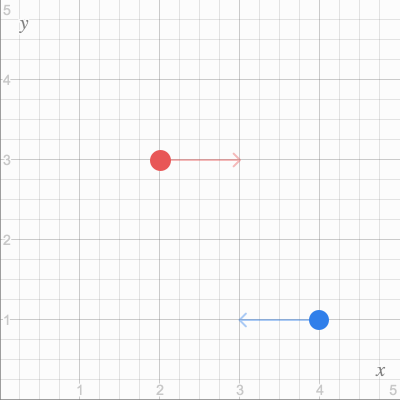
Then in vector form it can be represented as follows:
If we combine all this into one vector, we will get what we need
Derived function
To do this, solve the equation
Wow! The formula turned out high! But you can bring it into a more readable form if we break our vector
The quality of the simulation depends on the definition of these two derivatives, it is in them all the strength. And so that the simulation does not resemble a program where everything happens in a chaotic way, you can turn to physics for inspiration.
Kinematics and Dynamics
Kinematics and dynamics are essential ingredients to create an interesting simulation. Let's start with the very basics in our example.
Responsible for the position in space
It may seem that we have already found the function we need
And in fact, we brilliantly dealt with
Here Newton’s second law will help us:
So wait a minute
Suppose that in our simple example, the only force that acts on objects is gravitational attraction. In this case, we can determine
Where
To create the simulation itself, we also need a direction and somehow indicate
To summarize. The change of states in our system of two objects is fully expressed through variables
Now we have everything that distinguishes our simulation from all other simulations:
But how, having a strictly defined simulation, turn it into a beautiful animation?
If you had experience writing a simulation or a game, then maybe you can suggest something like this:
x += v * delta_t
v += F/m * delta_tBut let's stop a bit and see why this works.
Differential equations
Before we begin implementation, we need to decide what information we already have and what we need. We have a meaning
Bearing this in mind and looking closely at
The task of finding
Numerical integration
For some examples of Cauchy problems, you can easily find the answer by the analytical method, but in complex simulations the analytical approach can be very difficult. Therefore, we will try to find a way to find an approximate solution to the problem.
For example, take the simple Cauchy problem.
Given:
Consider the problem from a geometric point of view and look at the value and tangent at a point
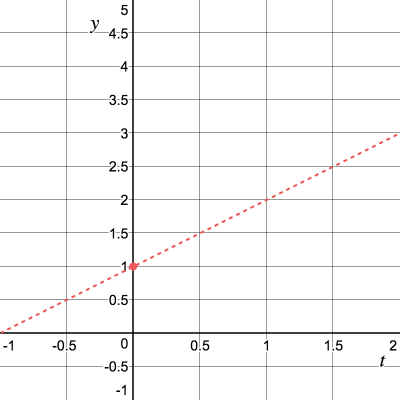
We don’t know what it looks like
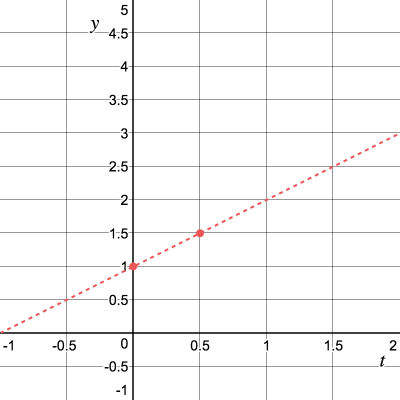
If you paint, then we approximate the value
So, for
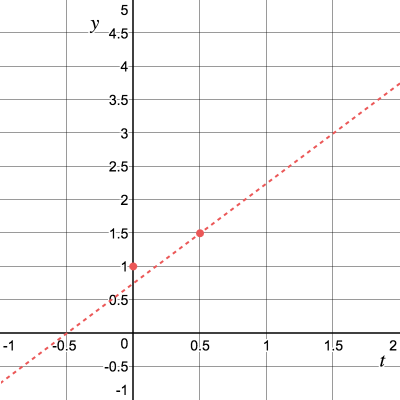
Next, let's move on
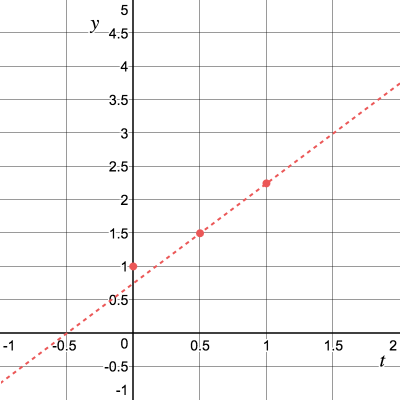
Repeat the process and get the tangent slope
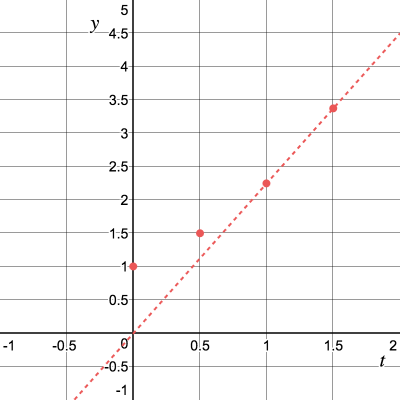
The procedure can be performed recursively and for this we derive the formula:
This numerical method for solving differential equations is called the Euler method. For the general case, a step
x += v * delta_t. In our particular case, a step-by-step solution looks like this:
Using this method, it is convenient to present the results in a table:
It turns out that our problem has a beautiful analytical solution

What do you think will happen if the step is reduced in the Euler method?
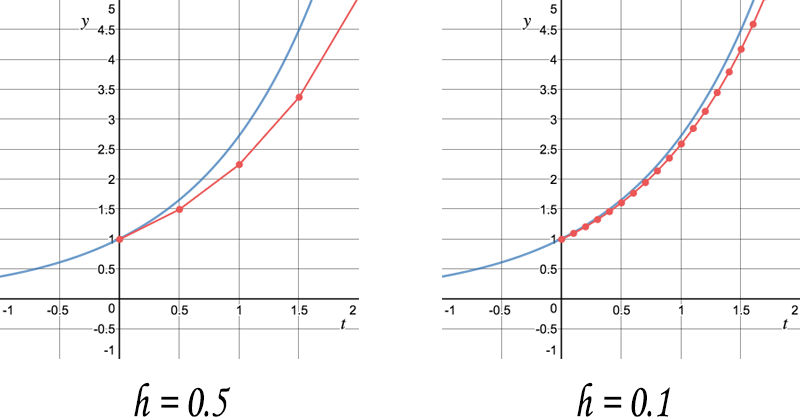
The difference between approximated and exact solutions decreases with decreasing
It is time to code!
With the same success as we deduced the mathematical representation of the description of the simulation, we can write the implementation of the simulation programmatically.
Because I am most familiar with JavaScript, and I like the clarity that annotations add to the code, all examples will be written in TypeScript .
And we will start with the version, which implied that
function runSimulation(
// y(0) = y0
y0: number[],
// dy/dt(t) = f(t, y(t))
f: (t: number, y: number[]) => number[],
// показывает текущее состояние симуляции
render: (y: number[]) => void
) {
// Шаг вперёд на 1/60 секунды за тик
// Если анимация будет 60fps то это приведёт к симуляции в рельном времени
const h = 1 / 60.0;
function simulationStep(ti: number, yi: T) {
render(yi)
requestAnimationFrame(function() {
const fi = f(ti, yi)
// t_{i+1} = t_i + h
const tNext = ti + h
// y_{i+1} = y_i + h f(t_i, y_i)
const yNext = []
for (let j = 0; j < y.length; j++) {
yNext.push(yi[j] + h * fi[j]);
}
simulationStep(tNext, yNext)
}
}
simulationStep(0, y0)
}It is not always convenient to operate with one-dimensional arrays; you can abstract the functions of adding and multiplying the simulation process into an interface and get a brief generalized simulation implementation using TypeScript Generics .
interface Numeric {
plus(other: T): T
times(scalar: number): T
}
function runSimulation>(
y0: T,
f: (t: number, y: T) => T,
render: (y: T) => void
) {
const h = 1 / 60.0;
function simulationStep(ti: number, yi: T) {
render(yi)
requestAnimationFrame(function() {
// t_{i+1} = t_i + h
const tNext = ti + h
// y_{i+1} = y_i + h f(t_i, y_i)
const yNext = yi.plus(f(ti, yi).times(h))
simulationStep(yNext, tNext)
})
}
simulationStep(y0, 0.0)
} The positive side of this approach is the ability to concentrate on the basis of the simulation: what exactly distinguishes this simulation from any other. We use the simulation example with the two objects mentioned above:
Code simulation of two objects
// Состояние симуляции двух объектов в один тик времени
class TwoParticles implements Numeric {
constructor(
readonly x1: Vec2, readonly v1: Vec2,
readonly x2: Vec2, readonly v2: Vec2
) { }
plus(other: TwoParticles) {
return new TwoParticles(
this.x1.plus(other.x1), this.v1.plus(other.v1),
this.x2.plus(other.x2), this.v2.plus(other.v2)
);
}
times(scalar: number) {
return new TwoParticles(
this.x1.times(scalar), this.v1.times(scalar),
this.x2.times(scalar), this.v2.times(scalar)
)
}
}
// dy/dt (t) = f(t, y(t))
function f(t: number, y: TwoParticles) {
const { x1, v1, x2, v2 } = y;
return new TwoParticles(
// dx1/dt = v1
v1,
// dv1/dt = G*m2*(x2-x1)/|x2-x1|^3
x2.minus(x1).times(G * m2 / Math.pow(x2.minus(x1).length(), 3)),
// dx2/dt = v2
v2,
// dv2/dt = G*m1*(x1-x1)/|x1-x2|^3
x1.minus(x2).times(G * m1 / Math.pow(x1.minus(x2).length(), 3))
)
}
// y(0) = y0
const y0 = new TwoParticles(
/* x1 */ new Vec2(2, 3),
/* v1 */ new Vec2(1, 0),
/* x2 */ new Vec2(4, 1),
/* v2 */ new Vec2(-1, 0)
)
const canvas = document.createElement("canvas")
canvas.width = 400;
canvas.height = 400;
const ctx = canvas.getContext("2d")!;
document.body.appendChild(canvas);
// Текущее состояние симуляции
function render(y: TwoParticles) {
const { x1, x2 } = y;
ctx.fillStyle = "white";
ctx.fillRect(0, 0, 400, 400);
ctx.fillStyle = "black";
ctx.beginPath();
ctx.ellipse(x1.x*50 + 200, x1.y*50 + 200, 15, 15, 0, 0, 2 * Math.PI);
ctx.fill();
ctx.fillStyle = "red";
ctx.beginPath();
ctx.ellipse(x2.x*50 + 200, x2.y*50 + 200, 30, 30, 0, 0, 2 * Math.PI);
ctx.fill();
}
// Запускаем!
runSimulation(y0, f, render) If you play with numbers, you can get a simulation of the orbit of the moon!
Simulation of the orbit of the moon, 1 pix. = 2500 km. 1 sec Simulation is 1 day on Earth. The proportion of the moon to the earth is increased 10 times
Collisions and restrictions
The above mathematical model actually simulates the physical world, but in some cases, the method of numerical integration, unfortunately, breaks down.
Imagine a simulation of a ball bouncing on the surface.
The simulation state can be described as follows:
Where
If you plot
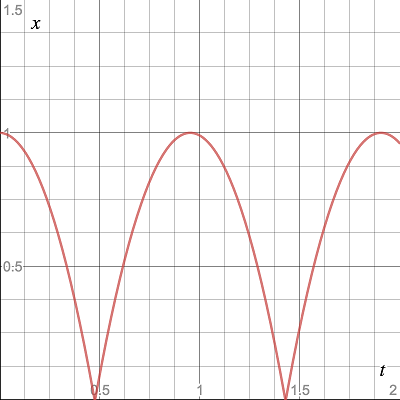
Derivative function during ball fall
With the acceleration of gravity,
But what happens when the ball touches the surface? That the ball has reached the surface we can find out by
This problem could be solved by determining the moment of collision
You can, of course, determine the collision in a limited period of time and apply another force
And in order to reduce the amount of penetration by the ball of the surface, it is possible to calculate several simulation steps in one tick at once. Together with this, the code of our simulation will change like this:
function runSimulation>(
y0: T,
f: (t: number, y: T) => T,
applyConstraints: (y: T) => T,
iterationsPerFrame: number,
render: (y: T) => void
) {
const frameTime = 1 / 60.0
const h = frameTime / iterationsPerFrame
function simulationStep(yi: T, ti: number) {
render(yi)
requestAnimationFrame(function () {
for (let i = 0; i < iterationsPerFrame; i++) {
yi = yi.plus(f(ti, yi).times(h))
yi = applyConstraints(yi)
ti = ti + h
}
simulationStep(yi, ti)
})
}
simulationStep(y0, 0.0)
} And now you can write the code of our bouncing ball:
Bouncing ball code
const g = -9.8; // m / s^2
const r = 0.2; // m
class Ball implements Numeric {
constructor(readonly x: number, readonly v: number) { }
plus(other: Ball) { return new Ball(this.x + other.x, this.v + other.v) }
times(scalar: number) { return new Ball(this.x * scalar, this.v * scalar) }
}
function f(t: number, y: Ball) {
const { x, v } = y
return new Ball(v, g)
}
function applyConstraints(y: Ball): Ball {
const { x, v } = y
if (x <= 0 && v < 0) {
return new Ball(x, -v)
}
return y
}
const y0 = new Ball(
/* x */ 0.8,
/* v */ 0
)
function render(y: Ball) {
ctx.clearRect(0, 0, 400, 400)
ctx.fillStyle = '#EB5757'
ctx.beginPath()
ctx.ellipse(200, 400 - ((y.x + r) * 300), r * 300, r * 300, 0, 0, 2 * Math.PI)
ctx.fill()
}
runSimulation(y0, f, applyConstraints, 30, render)
Attention to the developers!
Although this model has its advantages, it does not always lead to productive simulations. For me, such a framework is useful for representing the behavior of a simulation, even if a lot of unnecessary things happen in it.
For example, the rain simulation at the beginning of this article [ approx. In the original article, a beautiful interactive rain simulation was inserted at the beginning, I recommend that you look first-hand] was not created using the template described in the article. It was an experiment using Entity – component – system . The simulation source can be found here: rain simulation on GitHub .
See you later!
I find the intersection of mathematics, physics, and programming something really impressive. Creating a working simulation, running it and rendering it is a special kind of something out of nothing .
All of the above was inspired by the materials of the SIGGRAPH lecture, just like in the fluid simulation . If you want to find more comprehensive information about the above, then take a look at the materials of the SIGGRAPH 2001 course "Introduction to Physical Modeling" . I give a link to the 1997 course, as Pixar seems to have removed version 2001.
I want to thank Maggie Cai for the wonderful illustration of the couple under the umbrella and for their patience with painstaking selection of colors, while I can not distinguish between blue and gray.
And if you are interested, then the illustrations were created in Figma .
Only registered users can participate in the survey. Please come in.
Whether to translate the article “fluid simulation” (the link is given in the conclusion of the article)
- 96.8% Yes 154
- 3.1% No 5
